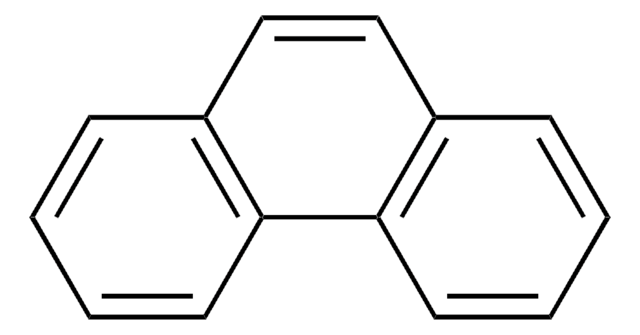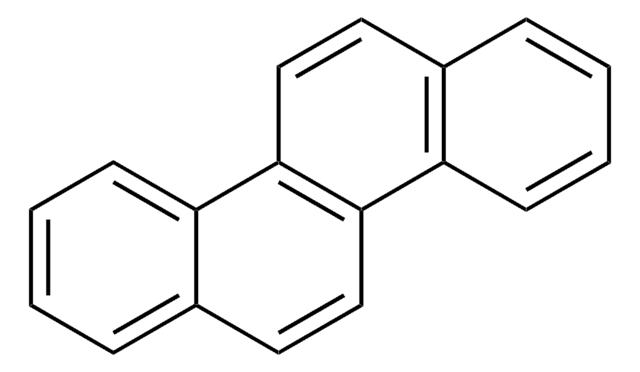All Photos(5)
About This Item
Empirical Formula (Hill Notation):
C16H10
CAS Number:
Molecular Weight:
202.25
Beilstein/REAXYS Number:
1907918
EC Number:
MDL number:
UNSPSC Code:
12352100
PubChem Substance ID:
NACRES:
NA.22
Recommended Products
Quality Level
assay
98%
bp
384 °C (lit.)
mp
105-110 °C (lit.)
SMILES string
c1ccc-2c(c1)-c3cccc4cccc-2c34
InChI
1S/C16H10/c1-2-8-13-12(7-1)14-9-3-5-11-6-4-10-15(13)16(11)14/h1-10H
InChI key
GVEPBJHOBDJJJI-UHFFFAOYSA-N
Looking for similar products? Visit Product Comparison Guide
Related Categories
application
Fluoranthene can be used as a starting material in the synthesis of:
- Polyfluoranthene (PFA) based conducting polymer (PFA) by electrochemical anodic oxidation using Lewis acid catalyst.
- Substituted fluorenones.
- Fluorescence-emitting oligofluoranthene (OFA) nanorods by oxidative oligomerization.
signalword
Warning
hcodes
Hazard Classifications
Acute Tox. 4 Oral - Aquatic Acute 1 - Aquatic Chronic 1
Storage Class
11 - Combustible Solids
wgk_germany
WGK 2
flash_point_f
388.4 °F - closed cup
flash_point_c
198.0 °C - closed cup
ppe
dust mask type N95 (US), Eyeshields, Gloves
Choose from one of the most recent versions:
Already Own This Product?
Find documentation for the products that you have recently purchased in the Document Library.
Customers Also Viewed
Efficient synthesis of oligofluoranthene nanorods with tunable functionalities
Li X-G, et al.
Chemical Science, 6(12) (2015)
Synthesis of 1-Substituted Fluorenones
George SRD, et al.
Polycyclic Aromat. Compd., 36(5), 697-715 (2016)
Electrochemical polymerization of fluoranthene and characterization of its polymers
Xu J, et al.
The Journal of Physical Chemistry B, 110(6), 2643-2648 (2006)
Marie Kummerová et al.
Chemosphere, 90(2), 665-673 (2012-10-18)
Introduced organic pollutants in all ecosystem compartments can cause stress resulting in a wide range of responses including different root development. In this study, the effects of a polycyclic aromatic hydrocarbon-fluoranthene (FLT; 0.1, 1 and 7 mg L(-1)) on the
Sherain N Al-Subiai et al.
Mutation research, 745(1-2), 92-103 (2012-01-11)
Whilst there is growing concern over the potential detrimental impact of engineered nanoparticles (ENPs) on the natural environment, little is known about their interactions with other contaminants. In the present study, marine mussels (Mytilus sp.) were exposed for 3 days
Our team of scientists has experience in all areas of research including Life Science, Material Science, Chemical Synthesis, Chromatography, Analytical and many others.
Contact Technical Service


![Benz[a]anthracene 99%](/deepweb/assets/sigmaaldrich/product/structures/351/486/b3ddf157-a732-4ef8-83f0-c70a53404cb2/640/b3ddf157-a732-4ef8-83f0-c70a53404cb2.png)

![Benzo[b]fluoranthene 98%](/deepweb/assets/sigmaaldrich/product/structures/175/744/6fa5fca2-b6ec-47b6-ab7a-fe895843f226/640/6fa5fca2-b6ec-47b6-ab7a-fe895843f226.png)

![Benzo[ghi]perylene 98%](/deepweb/assets/sigmaaldrich/product/structures/154/740/c50ff1be-dfb4-4159-a98c-9cecf9206ad3/640/c50ff1be-dfb4-4159-a98c-9cecf9206ad3.png)




